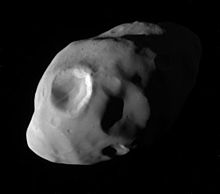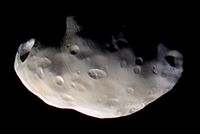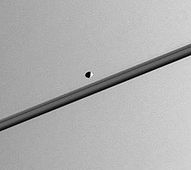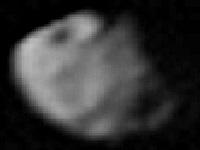 View of Pandora's western hemisphere.[a] | |
| Discovery | |
|---|---|
| Discovered by | Collins, Voyager 1 |
| Discovery date | October, 1980 |
| Designations | |
Designation | Saturn XVII |
| Pronunciation | /pænˈdɔːrə/ |
Named after | Πανδώρα Pandōra |
| Adjectives | Pandoran[1] |
| Orbital characteristics [2] | |
| Epoch December 31, 2003 (JD 2453005.5) | |
Semi-major axis | 141720±10 km |
| Eccentricity | 0.0042 |
| 0.628504213 d | |
| Inclination | 0.050°±0.004° to Saturn's equator |
| Satellite of | Saturn |
| Group | Possible outer shepherd moon of the F Ring |
| Physical characteristics | |
| Dimensions | 104 × 81 × 64 km [3] |
Mean radius | 40.7±1.5 km [3] |
| Volume | ≈ 280000 km3 |
| Mass | (1.371±0.019)×1017 kg[3] |
Mean density | 0.49±0.06 g/cm3[3] |
| 0.0026–0.0060 m/s2 [3] | |
Escape velocity | ≈ 0.019 km/s |
| synchronous | |
| zero | |
| Albedo | 0.6 |
| Temperature | ≈ 78 K |
Pandora is an inner satellite of Saturn. It was discovered in 1980 from photos taken by the Voyager 1 probe, and was provisionally designated S/1980 S 26.[4] In late 1985 it was officially named after Pandora from Greek mythology.[5] It is also designated Saturn XVII.[6]
Pandora was thought to be an outer shepherd satellite of the F Ring. However, recent studies indicate that it does not play such a role, and that only Prometheus, the inner shepherd, contributes to the confinement of the narrow ring.[7][8] It is more heavily cratered than nearby Prometheus, and has at least two large craters 30 kilometres (19 mi) in diameter. The majority of craters on Pandora are shallow as a result of being filled with debris. Ridges and grooves are also present on moon's surface.[9]
The orbit of Pandora appears to be chaotic, as a consequence of a series of four 118:121 mean-motion resonances with Prometheus.[10] The most appreciable changes in their orbits occur approximately every 6.2 years,[2] when the periapsis of Pandora lines up with the apoapsis of Prometheus and the moons approach to within about 1,400 kilometres (870 mi). Pandora also has a 3:2 mean-motion resonance with Mimas.[2]
From its very low density and relatively high albedo, it seems likely that Pandora is a very porous icy body. There is much uncertainty in these values, however, so this remains to be confirmed.
Gallery
Voyager 2 image of Pandora (August 1981).
References
- Notes
- ^ This view was taken by Cassini, during the spacecraft's close flyby on December 18, 2016. The image was taken from a distance of 40,500 kilometres (25,200 miles); the closest approach by the spacecraft during its 14-year tenure in the Saturn system.
- Citations
- ^ Robert Kolvoord (1990) Saturn's F ring: imaging and simulation, p. 104
- ^ a b c Spitale Jacobson et al. 2006.
- ^ a b c d e Thomas 2010.
- ^ IAUC 3532.
- ^ IAUC 4157.
- ^ USGS: Planet and Satellite Names and Discoverers.
- ^ Lakdawalla, E. (2014-07-05). "On the masses and motions of mini-moons: Pandora's not a "shepherd," but Prometheus still is". Planetary Society. Retrieved 2015-04-17.
- ^ Cuzzi, J. N.; Whizin, A. D.; Hogan, R. C.; Dobrovolskis, A. R.; Dones, L.; Showalter, M. R.; Colwell, J. E.; Scargle, J. D. (April 2014). "Saturn's F Ring core: Calm in the midst of chaos". Icarus. 232: 157–175. Bibcode:2014Icar..232..157C. doi:10.1016/j.icarus.2013.12.027. ISSN 0019-1035.
- ^ Solar System, NASA: Pandora.
- ^ Renner et al. 2005.
- Sources
- Marsden, Brian G. (October 31, 1980). "Satellites of Saturn" (discovery). IAU Circular. 3532. Retrieved 2011-12-29.
- Marsden, Brian G. (January 3, 1986). "Satellites of Saturn and Pluto" (naming the moon). IAU Circular. 4157. Retrieved 2011-12-29.
- Renner, Stéfan F.; Sicardy, Bruno; French, Richard G. (March 2005). "Prometheus and Pandora: Masses and orbital positions during the Cassini tour". Icarus. 174 (1): 230–240. Bibcode:2005Icar..174..230R. doi:10.1016/j.icarus.2004.09.005.
- "Saturn: Moons: Pandora". Solar System Exploration: Planets. NASA. 4 Apr 2011. Archived from the original on 2 June 2015. Retrieved 2011-12-29.
- Spitale, J. N.; Jacobson, R. A.; Porco, C. C.; Owen, W. M., Jr. (2006). "The orbits of Saturn's small satellites derived from combined historic and Cassini imaging observations". The Astronomical Journal. 132 (2): 692–710. Bibcode:2006AJ....132..692S. doi:10.1086/505206.
- Thomas, P. C. (July 2010). "Sizes, shapes, and derived properties of the saturnian satellites after the Cassini nominal mission" (PDF). Icarus. 208 (1): 395–401. Bibcode:2010Icar..208..395T. doi:10.1016/j.icarus.2010.01.025.
- USGS/IAU (July 21, 2006). "Planet and Satellite Names and Discoverers". Gazetteer of Planetary Nomenclature. USGS Astrogeology. Retrieved 2011-12-29.


_PIA_12690.jpg)
